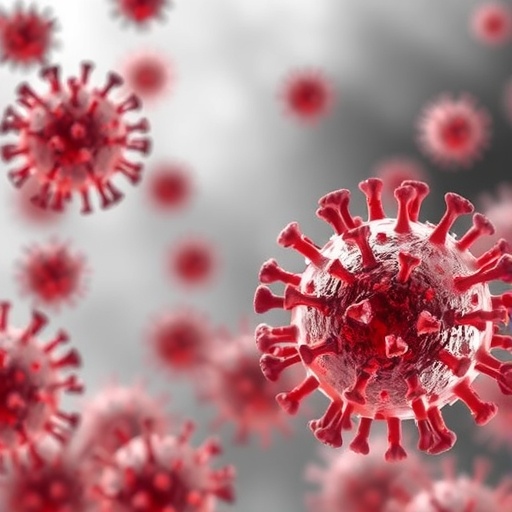In a groundbreaking revelation that challenges established notions of coronavirus host receptor interaction, researchers from the University of Hong Kong have uncovered that a clade of MERS-related coronaviruses, specifically the HKU25 lineage, utilize the angiotensin-converting enzyme 2 (ACE2) receptor for cellular entry. This discovery emerges as a significant pivot in the understanding of coronavirus evolution and interspecies transmission, particularly within the lineage previously thought to engage predominantly with the dipeptidyl peptidase 4 (DPP4) receptor.
The comprehensive study, spearheaded by Liu, Park, Ma, and colleagues, meticulously dissects the receptor usage of multiple representative coronaviruses from different betacoronavirus lineages. Historically, Middle East respiratory syndrome (MERS) coronaviruses have been characterized by their reliance on DPP4 as the principal gateway into host cells, a trait unequivocally distinct from the ACE2 dependency of SARS-CoV and SARS-CoV-2 viruses. By contrast, the HKU25 clade viruses reveal a surprising evolutionary adaptation, employing ACE2 with robust efficiency, as evidenced by a suite of biochemical and cell entry assays.
To reach these conclusions, the research team employed state-of-the-art pseudovirus systems mimicking authentic viral envelopes combined with comprehensive binding studies including surface plasmon resonance (SPR) and cryo-electron microscopy (cryo-EM) structural elucidations. These approaches demonstrated that the spike (S) glycoprotein of HKU25 viruses exhibits a receptor-binding domain (RBD) conformation optimized for ACE2 engagement, with affinity metrics comparable to or even exceeding those observed in some SARS-related coronaviruses.
This paradigm-shifting finding implicates that receptor tropism among betacoronaviruses is far more plastic than previously thought. It suggests an evolutionary continuum where multiple zoonotic coronaviruses might exploit ACE2 receptor pathways despite their phylogenetic relatedness to MERS-like viruses. The implications here are profound, as receptor usage critically influences viral host range and pathogenic potential, thereby impacting zoonotic spillover risk assessments.
The phylogenetic analysis integrated into the study illustrates that the HKU25 clade occupies a unique niche within the Merbecoviruses, diverging distinctly from canonical MERS-CoV strains. Intriguingly, the sequence and structural motifs of the HKU25 spike protein bear hallmarks of adaptation towards bat and possibly other mammalian ACE2 orthologues, underscoring the potential for cross-species transmission dynamics that merit urgent surveillance.
Furthermore, the research delineates the molecular interactions between HKU25 spike RBD and ACE2 receptors across different species, highlighting subtle yet consequential mutations in the receptor-binding interface. These mutations enhance the binding affinity for ACE2 variants found in bats, non-human primates, and even humans, suggesting a latent zoonotic threat that could translate into future outbreaks if spillover occurs.
Biologically, the findings contest the dogma that MERS-related coronaviruses are confined to DPP4-mediated cell entry, expanding the receptor repertoire concept within this lineage. This receptor shift could confer distinct cellular tropism and pathogenesis pathways, influencing tissue specificity and immune evasion strategies, elements critically linked to disease severity and transmission.
At a structural biology level, the detailed cryo-EM reconstructions reveal that the HKU25 spike protein’s RBD adopts an ACE2-binding configuration remarkably similar to that in SARS-CoV-2, with conserved contact residues establishing stable receptor interactions. This structural mimicry could represent convergent evolution optimized for ACE2 engagement. These insights provide a critical blueprint for antiviral drug design targeting receptor-spike interfaces across divergent coronavirus strains.
From an epidemiological perspective, the identification of ACE2 usage by HKU25 viruses elevates the urgency for enhanced viral surveillance in bat populations—natural reservoirs for a plethora of coronaviruses. Monitoring these viruses bears heightened importance given their demonstrated receptor compatibility with human ACE2, indicative of a tangible zoonotic transmission threat.
This research also bears significant implications for public health preparedness. Existing therapeutic strategies and vaccine designs predominantly focus on blocking incubation pathways associated with known receptor specificities. The expansion of recognized receptor usage to include ACE2 by emerging MERS-related viruses may necessitate a reevaluation of these countermeasures to ensure efficacy against a broader spectrum of coronaviruses.
Importantly, the study prompts a reexamination of coronavirus classification and host receptor co-evolution paradigms. The observed flexibility in receptor utilization hints at a more dynamic evolutionary landscape, where receptor switching or dual receptor usage might facilitate adaptation to novel hosts and ecological niches.
The discovery also underscores the vital importance of combining cutting-edge molecular biology, structural analysis, and virological assays to unravel viral entry mechanics. Such integrative methodologies are paramount to anticipating viral emergence patterns and devising robust intervention frameworks that preempt future pandemics.
Moreover, the identification of HKU25 clade viruses employing ACE2 highlights the need to augment diagnostic tools to detect an expanded array of coronavirus receptor interactions. Such enhancements would improve early detection of spillover events and refine risk mitigation strategies at the zoonotic interface.
Concluding, the study by Liu, Park, Ma, and colleagues markedly deepens the understanding of coronavirus biology, challenging entrenched assumptions and opening new vistas for research into viral evolution, zoonosis, and pandemic preparedness. Their seminal work invites the scientific community to consider ACE2 not only as a receptor for SARS-related viruses but also as a key player exploited by certain MERS-related coronaviruses, heralding a nuanced appreciation of viral adaptability at the molecular level.
As the world continues to grapple with the ramifications of coronavirus pandemics, insights into receptor usage illuminate crucial pathways for therapeutic innovation, vaccine development, and surveillance. The unexpected receptor flexibility of HKU25 viruses serves as a clarion call to expand investigative horizons and foster interdisciplinary collaboration aimed at forestalling the next global viral threat.
Subject of Research: Virology and coronavirus receptor usage.
Article Title: HKU25 clade MERS-related coronaviruses use ACE2 as a functional receptor.
Article References:
Liu, C., Park, YJ., Ma, CB. et al. HKU25 clade MERS-related coronaviruses use ACE2 as a functional receptor. Nat Microbiol (2025). https://doi.org/10.1038/s41564-025-02152-y
Image Credits: AI Generated
Tags: ACE2 receptor utilizationbiochemical assays in virologycoronavirus host interactioncoronavirus receptor binding studiescryo-electron microscopy studiesDPP4 receptor comparisonHKU25 cladeinterspecies transmissionMERS coronavirusespseudovirus systems in researchreceptor evolution in coronavirusesspike glycoprotein function





